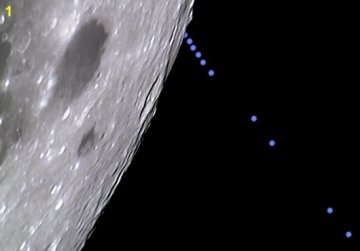 Autumn is here, and it's a wonderful time for stargazing. Find out what's up from Spaceweather PHONE.
Autumn is here, and it's a wonderful time for stargazing. Find out what's up from Spaceweather PHONE.
QUIET SUN: Solar activity doesn't get much lower than it is today: There are no sunspots, no coronal holes and no solar wind streams heading toward Earth. Furthermore, the sun's x-ray glow is at its dimmest. It's just a quiet day on the sun.
Warning: Declarations of "Quiet Sun!" have been known to stir up solar activity. Stay tuned.
TURQUOISE AND GRAY: The beautiful turquoise color of Uranus is a joy to behold in the eyepiece of a backyard telescope. It looks even better next to the gray mountains of the Moon:

Dennis Simmons of Brisbane, Australia, assembled this image from pictures he took moments before a lunar occultation of Uranus on Sept. 8th. Using his 9-inch telescope, he also spotted the planet's Shakespearean moons, Titania and Oberon.
Ready to see for yourself? The Turquoise Planet is easy to find in the constellation Aquarius just after sunset: sky map.
INSIDE A RAINBOW: The next time you see a rainbow, look carefully at the colors. There's red on the outside, then orange, yellow, green and, finally, on the inside, blue.
That's how a rainbow stops, on blue. Except this rainbow, photographed Oct 5th by Martin McKenna of Maghera, Northern Ireland, kept going--green, purple, green, purple, green:

Atmospheric optics expert Les Cowley explains: "The extra bows just inside the primary rainbow are called supernumeraries. They were so named because 17th century theories of the rainbow could not explain them -- they were thought of as extras and not supposed to exist! Supernumeraries are produced by the interference between light waves and nowadays they tell us that the raindrops are small."
"Want to make your own clear and sharp supernumeraries? Look at the rainbow in the fine spray of a garden hose."

